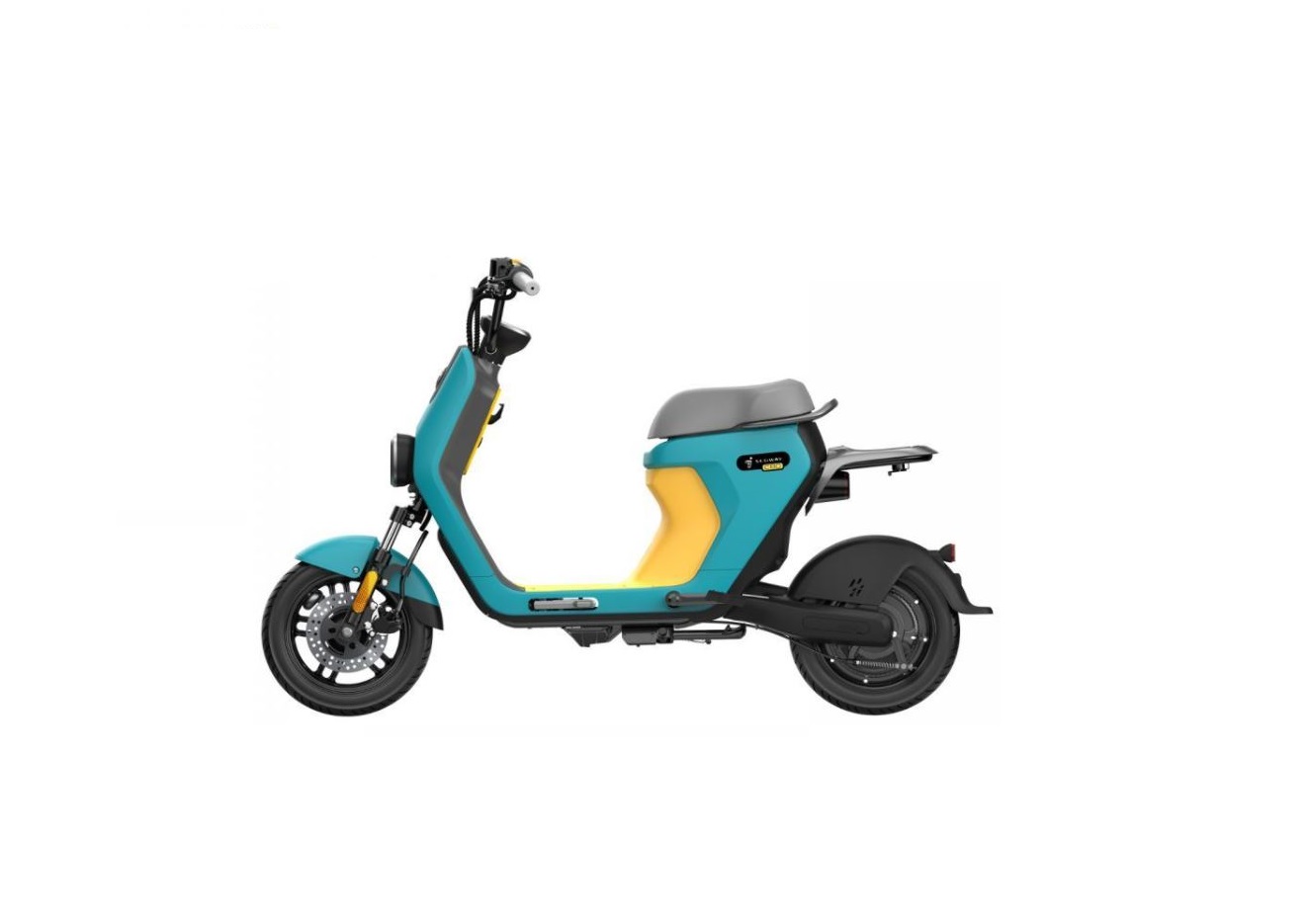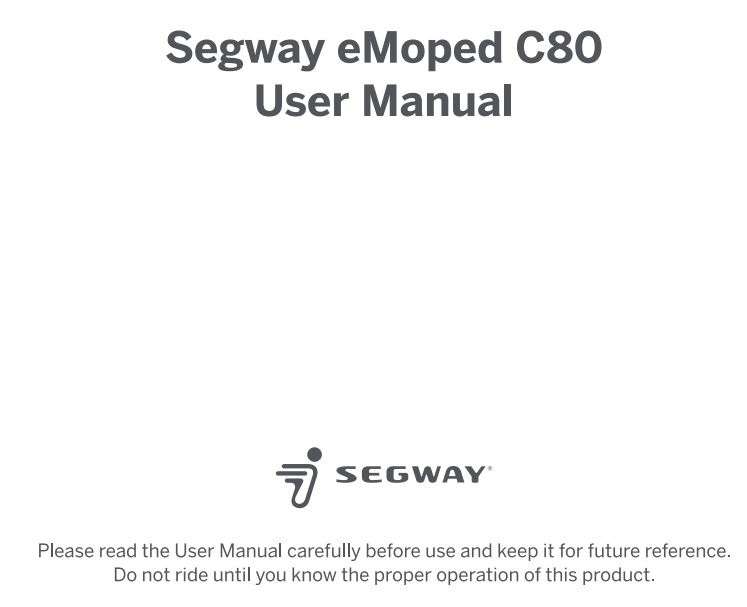SEAGWAY eMoped C80 Smart Electric Bike User Manual
WelcomeThank you for choosing Segway eMoped C80!Combining advanced wireless positioning technology and smart App control, Segway eMoped C80 promises a brand-new riding experience, which is safe, intelligent, and also brings out the rider’s personality.
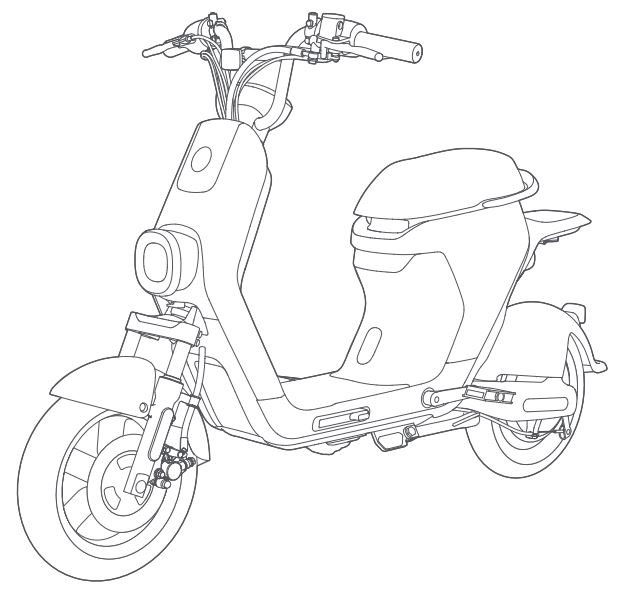
The pictures shown are for illustration purpose only. Actual product may vary.
1. Riding Safety
Remember that whenever you ride the product, you risk injury from loss of control, collisions, and falls. To reduce the risk, you must read and follow all “CAUTION” and·’![]() , WARNING” notices. Please understand that you can reduce the risk by following the instructions and warnings in this manual, but you cannot eliminate all the risks. Please use common sense when riding.
, WARNING” notices. Please understand that you can reduce the risk by following the instructions and warnings in this manual, but you cannot eliminate all the risks. Please use common sense when riding.
- It is the rider’s responsibility to follow local laws and regulations and abide by relevant laws and traffic regulations. ONLY ride on the roads as permitted by law.
- In order to master riding skills, the rider needs to practice. Use with caution since skill is required to avoid falls or collisions causing injury to the user or third parties. To avoid injuries, DO NOT allow people who don’t know the proper operation to ride the product. Neither Ninebot (Ninebot (Beijing) Tech Co., Ltd. and its subsidiaries and affiliates) nor Segway (Segway Inc. and its subsidiaries and affiliates) is responsible for any injuries, damages or legal disputes caused by a rider’s inexperience or failure to follow the instructions in this manual.
- For your safety, please DO NOT modify the product or change parts by yourself. Use only Segway approved parts and accessories. Modifications to the product could interfere with its operations, result in serious injury and/or damage, or void the Limited Warranty.
- If the product makes an abnormal sound or signals an alarm, stop riding immediately.
- DO NOT allow anyone to ride the product on his/her own unless he/she has carefully read this manual. Assist new riders until they are comfortable with the basic operation of Segway eMoped C80.
- DO NOT park Segway eMoped C80 in no-parking zones, such as an emergency exit. building lobbies or fire escapes.
- Do not charge or park the product in residential buildings. Keep away from combustible materials when charging, and disconnect from the power supply once it’s fully charged.
Riding Surfaces and Environment:
- Slow down when riding in complicated road conditions. Riding at a high speed to cross over obstacles, on uneven ground, slippery surfaces, loose ground, steep slope or at sharp turns, can lead to falls, collisions or even death.
- DO NOT ride in bad weather such as heavy rain or storm. When riding in rainy or snowy weather, the traction is reduced and the braking distance is increased. For your safety, please drive slower and brake earlier to reduce the risks for loss of control and falls.
Who Should Not Ride:People in the following groups should not ride Segway eMoped C80:
- Anyone under the influence of alcohol, drugs, or intoxicants.
- Anyone who suffers from diseases that put them at risk if they engage in strenuous physical activity.
- Anyone whose age and weight is outside the stated limits (See Specifications).
- People who are extremely tired.
Preparations before Riding:
- Make sure there are no loose fasteners and damaged parts.
- Check the status of the power supply circuit. lighting, dashboard display, etc. and make sure they work normally.
- The front and rear brakes should function properly and the brake cables should be in good condition.
- Make sure the handlebar is stable, and that the front and rear wheels are not shaky or loose.
- Make sure the reflectors are not damaged or dirty.
- The rider must wear a helmet and other protective gear.
- DO NOT carry heavy cargo.
- When the battery is low (the dashboard shows less than two bars), please use the original charger to charge immediately.
- Ensure normal tire pressure, with front tire 26 psi (180 kPa) and rear tire 32 psi (220 kPa). Make sure the tire tread is intact.
![]()
![]()
![]()
![]()
![]()
![]()
![]()
![]()
![]()
![]()
![]()
![]()
![]()
![]()
![]()
![]()
![]()
![]()
![]()
Always wear a helmet when riding. Use an approved helmet that fits properly with the chin strap in place, and provides protection for the back of your head.
Instructions on Riding and Usage:
- DO NOT accelerate or brake abruptly when riding.
- Please hold the handlebar with both hands to avoid serious injuries due to loss of balance or falling.
- Stay alert and ride defensively. Always keep a safe distance from other vehicles. Slow down when entering a new environment.
- DO NOT use a cell phone, camera, headphones, earbuds or perform any other activities while riding.
- Slow down when approaching intersections, motorways, corners, doors, etc. Yield the right of way for pedestrians, bicycles and motor vehicles.
- If any abnormality occurs, stop riding immediately and contact the after-sales service in time. DO NOT ride before the cause of the abnormality is found out and repaired.
- Always park Segway eMoped C80 on a flat surface. Otherwise, the vehicle may slip and cause harm.
- ONLY use the original charger. Allow the vehicle to stay still for a while before charging. Do not attempt to charge your vehicle if it. the charger, or the power outlet is wet.
2. Product Overview
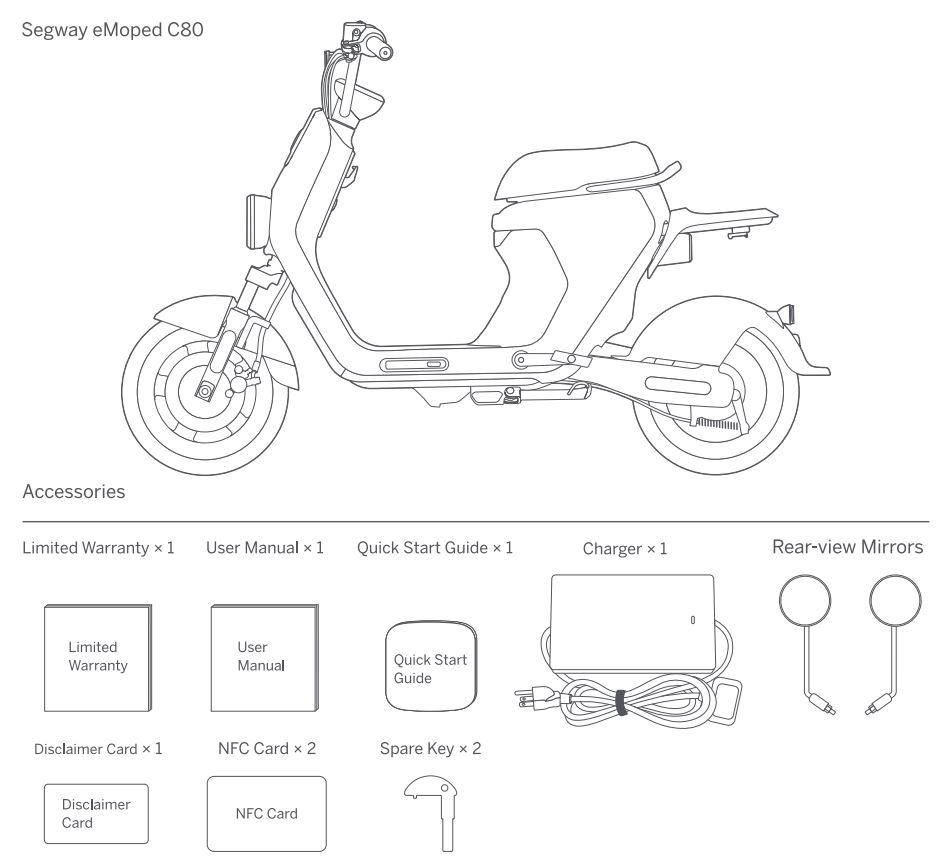

Spare Key


3. Parts and Functions


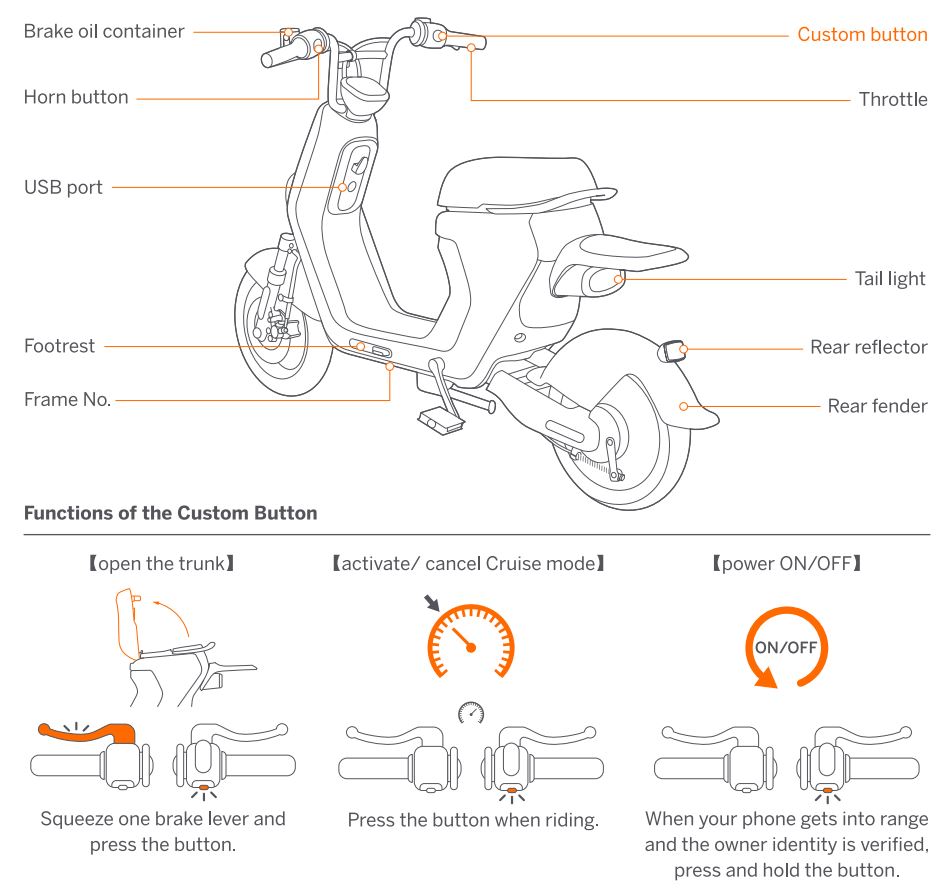



4. Activate the Vehicle
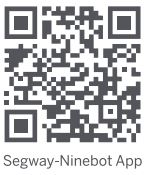

An eMoped C80 that has not been activated is limited to 6.2mph (10 km/h) and the Airlock does not work .
To enjoy the full functionality of the vehicle, please scan the QR code to download the Segway-Ninebot App (hereinafter referred to as the App) and finish the New Rider Tutorial. Alternatively, go to the Google Play Store (Android) or the Apple App Store (iOS) and search for “Segway” or “Ninebot” to download and install the App. To ensure Bluetooth communication. keep your phone close to the vehicle during the activation process.
- Install the App, register and log in.


- Power on Segway eMoped C80 (see details on page 11). A flashing phone connection indicator means the vehicle is waiting for a connection.

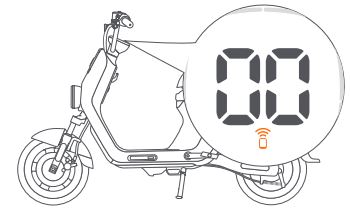
- Click ‘Search vehicle’ to connect to your Segway eMoped C80. The Bluetooth signal will stop flashing when the connection is successful.

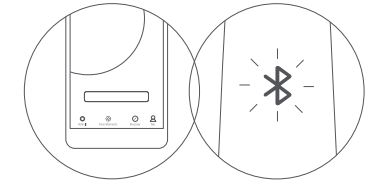
- Follow the instructions to activate your vehicle and complete the New Rider Tutorial. The speed limit is now lifted and the Airlock is activated.
5. How to Charge
The battery level may be low or empty during transportation and storage. You can charge in any one of the methods below. Remember to unplug from the power supply once fully charged.
(1) Charge the Vehicle
Connect the battery power plug, then close the trunk. Connect the charger output to the vehicle charging port, and then connect to the power outlet.


(2) Internal ChargingConnect the charger output to the battery charging port, plug into the power outlet, and then close the trunk.


(3) Charge the BatteryOpen the trunk and take out the battery. Connect the charger output to the battery charging port. and then connect to the power outlet.


*The charger indicator is red when charging and turns to solid green when fully charged.If the temperature of the vehicle body exceeds 104°F (40°C). it cannot be charged normally. Please wait for the temperature to drop.
![]()
![]()
![]()
![]()
![]()
![]()
![]()
![]()
![]()
![]()
![]()
![]()
![]()
![]()
![]()
![]()
![]()
![]()
![]()
- ONLY use the original charger. Other types can burst and catch fire.
- DO NOT charge if the battery is wet or damaged.
- DO NOT connect the charger when the charging port or charging cable is wet.
6. How to Install the Battery
After charging the battery, please put it into the vehicle in the following steps:
(1) Open the trunk by any of the following methods.
- Use the key.

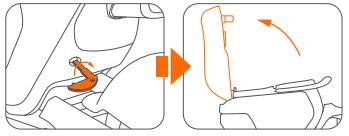
- Squeeze one brake lever and tap the NFC card on the dashboard.


- If the battery is in the vehicle, squeeze one brake lever and hold the custom button. If the battery is not in, press and hold the custom button, wait until the E, F, as well as the phone connection signal light up, and then squeeze one brake lever while holding the custom button.* Please enable the Airlock in the App in advance. Make sure the ECU battery is not empty. You can check the battery level in the App.


(2) Put the battery in the vehicle, connect the battery power plug and close the trunk.


7. Learn to Ride


![]()
![]()
![]()
![]()
![]()
![]()
![]()
![]()
![]()
![]()
![]()
![]()
![]()
![]()
![]()
![]()
![]()
![]()
![]()
Always wear a helmet and other protective gear to minimize any possible injury in the learning process. Always abide by local laws and traffic rules.
Power onThe vehicle can be powered on in one of the following ways:
- Tap the NFC card on the dashboard. You will hear a beep when the vehicle is powered on successfully.


- Enable the Airlock in the App. The vehicle will power on when you sit on the saddle, or press and hold the custom button.
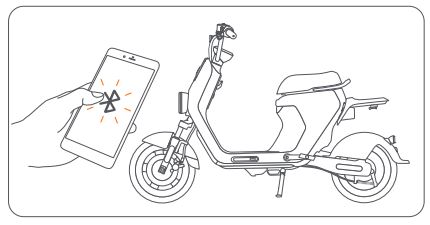

Riding
Kick up the kickstand, sit down on the saddle and support yourself with both feet. Gently turn the throttle inward to start your trip.


NOTE:
Before the rider is seated, the status rings are orange and the throttle cannot be started. If the rider leaves the seat during riding, an alarm will start, and the throttle will not work.
Locking
Release the throttle and hold the front and rear brake levers with appropriate force. After the vehicle has stopped, support it with the kickstand. You can lock your Segway eMoped C80 in the following ways:
- Auto lock Enable the ‘Auto lock’ feature in the App. When you walk away with the phone, the vehicle will lock automatically.
- Press and hold the custom button.
- Tap the NFC card.
NOTE:
- After locking, please turn the handlebar to its left end to ensure that the Handlebar Lock is activated.
- The control switch of the Handlebar Lock is located inside the trunk. You can operate the switch to enable/disable the lock.
Anti-theft AlarmAfter Segway eMoped C80 is locked, if there is abnormal movement, the status rings will flash in red and green and a continuous alarm will start.
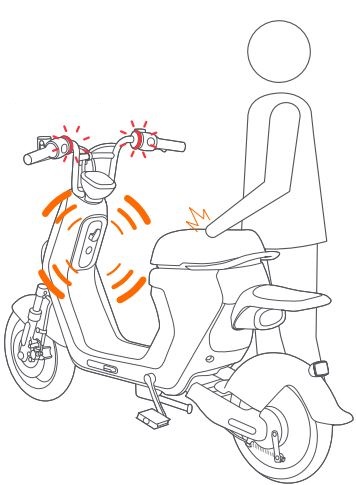

8. Warnings and Cautions
Please avoid all dangerous riding behaviors!
![]()
![]()


![]()
![]()
![]()
![]()
![]()
![]()
![]()
![]()
![]()
![]()
![]()
![]()
![]()
![]()
![]()
![]()
![]()
![]()
![]()
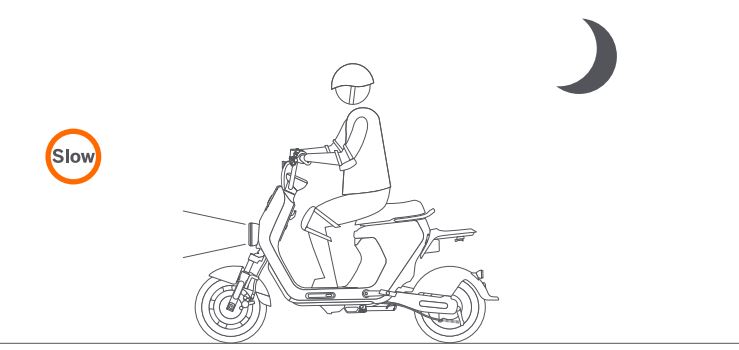

![]()
![]()
![]()
![]()
![]()
![]()
![]()
![]()
![]()
![]()
![]()
![]()
![]()
![]()
![]()
![]()
![]()
![]()
![]()


![]()
![]()
![]()
![]()
![]()
![]()
![]()
![]()
![]()
![]()
![]()
![]()
![]()
![]()
![]()
![]()
![]()
![]()
![]()
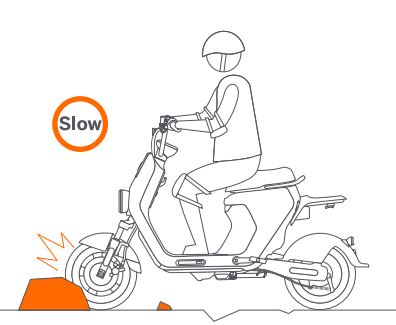

![]()
![]()
![]()
![]()
![]()
![]()
![]()
![]()
![]()
![]()
![]()
![]()
![]()
![]()
![]()
![]()
![]()
![]()
![]()
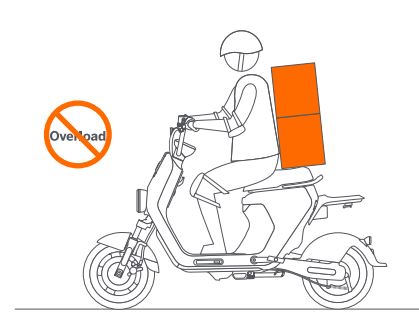

![]()
![]()
![]()
![]()
![]()
![]()
![]()
![]()
![]()
![]()
![]()
![]()
![]()
![]()
![]()
![]()
![]()
![]()
![]()
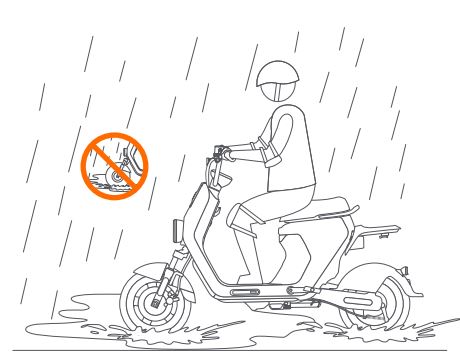

![]()
![]()
![]()
![]()
![]()
![]()
![]()
![]()
![]()
![]()
![]()
![]()
![]()
![]()
![]()
![]()
![]()
![]()
![]()
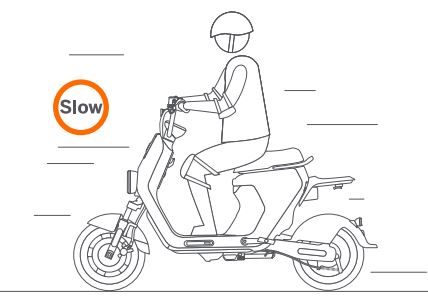

![]()
![]()
![]()
![]()
![]()
![]()
![]()
![]()
![]()
![]()
![]()
![]()
![]()
![]()
![]()
![]()
![]()
![]()
![]()
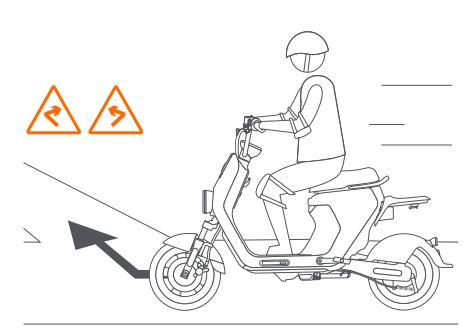

![]()
![]()
![]()
![]()
![]()
![]()
![]()
![]()
![]()
![]()
![]()
![]()
![]()
![]()
![]()
![]()
![]()
![]()
![]()
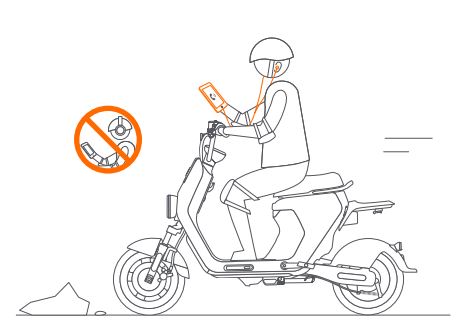

![]()
![]()
![]()
![]()
![]()
![]()
![]()
![]()
![]()
![]()
![]()
![]()
![]()
![]()
![]()
![]()
![]()
![]()
![]()
9. Maintenance
CleaningClean with water, neutral detergent and a soft cloth.
CAUTIONDO NOT clean with alcohol, gasoline, acetone, or other corrosive/volatile solvents. These substances may damage the appearance and internal structure of your vehicle. DO NOT wash with a power washer or hose. DO NOT rub with sandpaper or metal brush.
![]()
![]()
![]()
![]()
![]()
![]()
![]()
![]()
![]()
![]()
![]()
![]()
![]()
![]()
![]()
![]()
![]()
![]()
![]()
Before cleaning, make sure the vehicle is powered off.
Storage
Store in a dry and cool place indoors and avoid sunlight and rain, so as not to rust parts and shorten the service life. Disconnect the battery power plug for long-time storage to prevent over-discharge.
Motor
- When riding in wet conditions, the water level should not exceed the central axis of the rear wheel.
- Regularly check the motor connectors (the hub motor is in the rear wheel). If the nuts and bolts are loose, tighten immediately.
- Clean the vehicle after each ride to prevent particles from entering the motor and affecting its normal use. Do not spray water directly when cleaning.
- Check whether the motor leads are scratched and whether there is abnormal noise when the motor is running.
Motor controllerCheck the connector regularly at an authorized service center to ensure that it is fastened.
Battery
- DO NOT drain the battery. It is recommended to keep the battery level above 15%. Charge after each ride to prolong the service life of the battery.
- It is strictly prohibited to disassemble the battery. There is a danger of electric shock, short circuit, fire, explosion, etc.
- When the battery indicator bars are all lit up or the charger indicator turns green, it means the battery is fully charged.
- The storage temperature for the battery is 32-95°F (0-35°C).
- If you are not going to use the vehicle for a long time, take out the battery after it is fully charged, place in a dry and well-ventilated place, and charge it every two months.
- DO NOT store the battery in a place where there is a risk of falling. Falling may cause battery damage, short circuit, fire and explosion.
![]()
![]()
![]()
![]()
![]()
![]()
![]()
![]()
![]()
![]()
![]()
![]()
![]()
![]()
![]()
![]()
![]()
![]()
![]()
![]()
![]()
![]()
![]()
![]()
![]()
![]()
![]()
![]()
![]()
![]()
![]()
![]()
![]()
![]()
![]()
![]()
![]()
![]()
- The charger should ONLY be used to charge the original vehicle/battery. It is strictly prohibited to charge non-rechargeable batteries.
- To prevent the electronic components inside the charger from loosening, DO NOT carry the charger in the vehicle.
- The power supply voltage should be 100-240V AC.
- DO NOT use when there are broken cables or loose connectors.
• During charging:
- Place the vehicle in a safe place away from rain and sun exposure.
- Connect to the battery or vehicle charging port first, and then plug into the power supply.
- When there is an abnormal smell, sound or light display, stop charging immediately and contact after-sales service.
• After charging:
- When the battery is full, disconnect from the power outlet first and then unplug the charger plug.
- After the charger cools down, place it in a safe place inaccessible to children.
![]()
![]()
![]()
![]()
![]()
![]()
![]()
![]()
![]()
![]()
![]()
![]()
![]()
![]()
![]()
![]()
![]()
![]()
![]()
- Ensure good ventilation during charging. Stay away from fire or explosive materials!
- High voltage in the charger! DO NOT disassemble or replace parts of the charger.
- DO NOT connect the charger to the power outlet for a long time. Unplug from the power outlet when not charging. DO NOT use the charger to charger multiple vehicles.
- The charger should be handled with care. Keep away from outdoor elements such as rain and heat.
NOTICE: INSURANCE YOUR INSURANCE POLICIES MAY NOT PROVIDE COVERAGE FOR ACCIDENTS INVOLVING THE USE OF THIS PRODUCT. TO DETERMINE IF COVERAGE IS PROVIDED, PLEASE CONTACT YOUR INSURANCE COMPANY OR AGENT.
Maintenance Guideline
- Perform the first maintenance after 621 miles (1,000 km) mileage or riding for 3 months.
- After the first maintenance, it is recommended to maintain your vehicle every 1243 miles (2,000 km) or riding for 6 months.
Specific maintenance schedule and items:
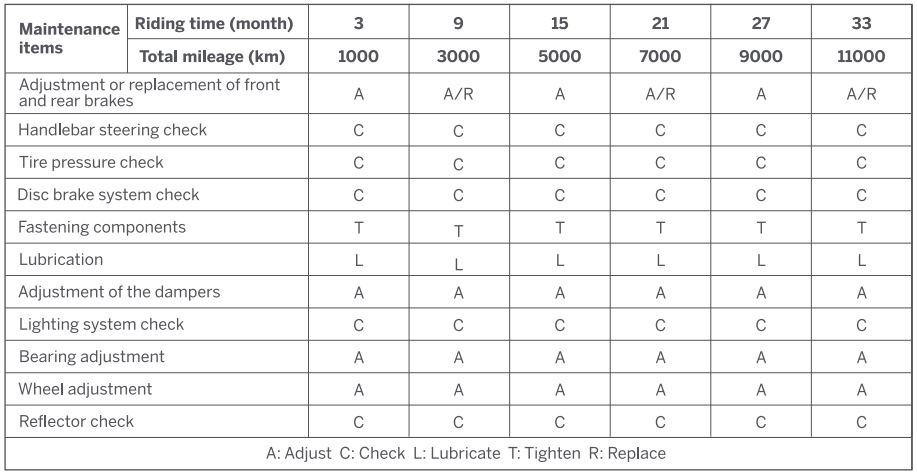

Maintenance instructions:


10. Specifications




[1] Typical Range: tested while riding with full battery.165 lbs. (75 kg) load. 77 °F (25 °C). wind speed ,;;3 m/s.12 mph (20 km/h) on average on paved road.* Some of the factors that affect range include: rider weight, number of starts and stops, ambient temperature, etc.
Error Codes, Failures and Solutions
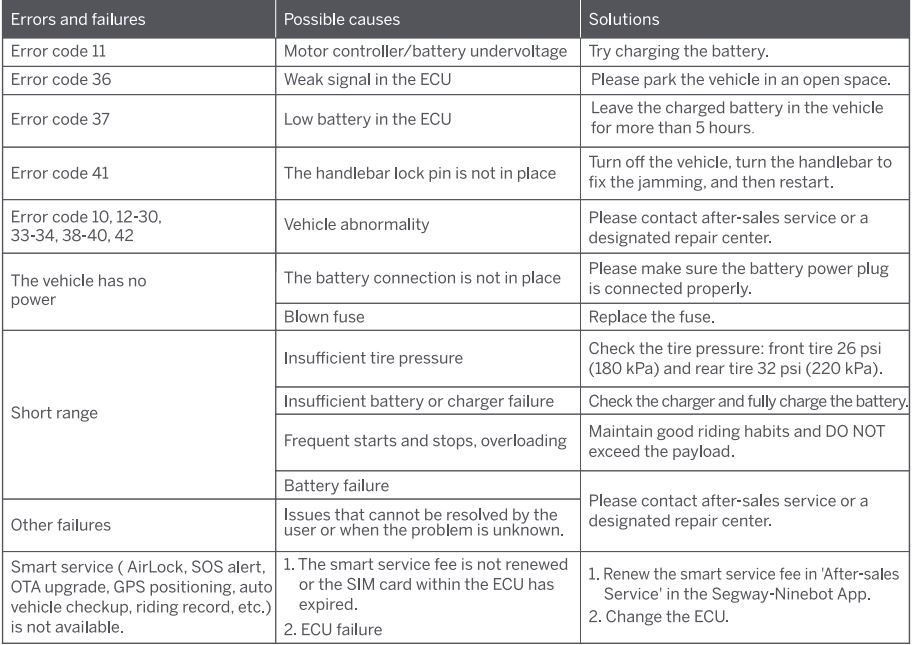

11. Certifications
This product complies with 16 CFR PART 1512:2019The battery complies with UN/DOT 38.3.The battery complies with ANSI/UL 2271.
Federal Communications Commission (FCC) Compliance Statement for USAThis device complies with part 15 of the FCC rules. Operation is subject to the following two conditions:(1) This device may not cause harmful interference, and (2) this device must accept any interference received, including interference that may cause undesired operation.
NOTEThis equipment has been tested and found to comply with the limits for a Class B digital device, pursuant to part 15 of the FCC Rules. These limits are designed to provide reasonable protection against harmful interference in a residential installation. This equipment generates, uses and can radiate radio frequency energy and, if not installed and used in accordance with the instructions, may cause harmful interference to radio communications. However, there is no guarantee that interference will not occur in a particular installation. If this equipment does cause harmful interference to radio or television reception, which can be determined by turning the equipment off and on, the user is encouraged to try to correct the interference by one or more of the following measures:– Reorient or relocate the receiving antenna.– Increase the separation between the equipment and receiver.– Connect the equipment into an outlet on a circuit different from that to which the receiver is connected.– Consult the dealer or an experienced radio/TV technician for help.This equipment complies with FCC radiation exposure limits set forth for an uncontrolled environment.
Industry Canada (IC) Compliance Statement for CanadaThis device complies with Industry Canada license-exempt RSS standard (s). Operation is subject to the following two conditions: (1) this device may not cause interference, and (2) this device must accept any interference, including interference that may cause undesired operation of the device.Neither Segway Inc. nor Ninebot is responsible for any changes or modifications not expressly approved by Segway Inc. or Ninebot. Such modifications could void the user’s authority to operate the equipment.
Contains FCC ID: XMR201909EC25AFX IC: 10224A-2019EC25AFX FCC ID: 2AU2Y-JH0001 IC: 25633-JH000l
12. Trademark and Legal Statement
Segway and the Rider Design are the registered trademarks of Segway Inc., Ninebot is the registered trademark of Ninebot (Tianjin) Tech Co., Ltd; Bluetooth is the registered trademark of BLUETOOTH SIG.INC.; Android, Google Play are trademarks of Google Inc., App Store is a service mark of Apple Inc., The respective owners reserve the rights of their trademarks referred to in this manual. We have attempted to include descriptions and instructions for all the functions of the Segway eMoped C80 at the time of printing. However, due to constant improvement of product features and changes of design, your eMoped may differ slightly from the one shown in this document. Please visit the Apple App Store (iOS) or Google Play Store (Android) to download and install the App. and visit www.segway.com to download the latest user materials.
Please note that there are multiple Segway and Ninebot models with different functions, and some of the functions mentioned herein may not be applicable to your unit. The manufacturer reserves the right to change the design and functionality of the Segway eMoped C80 product and documentation without prior notice.
© 2020 Ninebot (Beijing) Tech Co., Ltd. All rights reserved.
IMPORTANT: The user shall agree to read the entire user manual and fully understand its content (especially the parts related to warnings and caution statements) and adhere to the instructions herein before riding this product. Be aware, this product is an electronic bike that is very different from a traditional man powered bicycle.
- This product can be dangerous to a user, other persons and property in proximity thereto. The user shall assume all the risks and loss in connection with the product (especially for those related to and/or arising out of violation of the instructions about warnings and caution statements). Such risks include but not limited to loss of control, failure of the product and/or collusion) The consequences for such incident can be severe, including but not limited to injuries, bodily injuries, death and/or damages to property. SEGWAY and its affiliates shall not be liable for any claim, liability and loss related to such consequences, if it is due to the user’s assumption of risk.
- The product is a means for transportation and the user may not have necessary and sufficient experience and skills to ride it, especially in complex environments and/or undesirable road and/or traffic conditions. Such risk may increase if the user has physical and/or mental impairment or disability, or a user is under the influence of alcohol, drugs or similar substance. Such risk may also increase if the user is not sufficiently familiar with the functions, features and performance of the product. Thus, the user, especially new users, shall learn and practice how to ride this product properly and safely. Experience accumulated by practice would normally enable a user to better ride and operate the product by time.
- The parts and components of the product are subject to fatigue, wear and tear (“Wear and Tear”). Many factors, such as environment, aging road conditions and/or riding behaviors may affect the rate of Wear and Tear. Wear and Tear may cause unanticipated and/or sudden failure of the product, which may cause, inter alia, severe bodily injury or even death. So, the user shall regularly and periodically, as the circumstance requires, inspect and maintain the product. The user shall also conduct reasonable examination and inspection of the product every time before riding it. For instance, every time before riding the product, the user shall check and examine tire performance, battery level, brake (including brake cable and that the brake shall have proper tension), vehicle installation status and all functional parts. If abnormality, discoloration or change of color of material (especially in an area that receives high stress when the product is in motion or junction), scratch, crack, loose fasteners, and/or missing parts (such as screw, bolts and/or nut) which strongly indicates that it is not safe to ride the product.
- Since it is impossible to predict and/or anticipate all and every scenario, condition and/or circumstances under which a product user may be exposed to risk and danger, the User Manual is not intended to be an exhaustive list on how to ride the product safely and/or avoid hazards related to the product. So, in addition to adhere to the instructions, the user shall also ride and/or use the product with responsibility, carefulness, precaution and best judgment. The user should always be a responsible rider, cautious, maintain proper speed and avoid all dangerous riding behaviors, as well as traffic and/or road conditions when riding the product. For instance, you shall avoid speeding, overloading or performing stunts of any kind. Do not try to touch the tires with your hands or feet when riding. Do not carry people on the rear rack. One rider only.
- The user shall check and obey the local laws or regulations over the product. It is the sole user’s responsibility that he/she shall ride, use and/or dispose of the product in compliance with the law. The law and regulations may be different in different jurisdictions. Apart from the others, such laws and regulation may include:(1) A helmet may be legally required by local law or regulation in your jurisdiction.(2) Vehicle registration and a license plate may be legally required by local law or regulation in your area.(3) Your eMoped may not be allowed to be driven in motorway or highway. You may obtain more information related to legal requirements on eMoped from your local government.
- A consumer shall immediately check whether the product and its accessories are in good condition upon receipt of the product.
- All the separate components and part of the products must be properly installed per the User Manual. Inappropriate installation and/or assembly may significantly increase the risk of loss of control, product failure, collisions and falls. The product may contain removable components and small parts. Please keep them out of the reach of children to avoid choking hazard.
- Do not dispose of this product in a landfill, by incineration, or by mixing with household trash. Serious danger/ injury can occur because of the electrical components and the battery. For information about battery and electrical waste, please contact your household waste disposal service, your local or regional waste management office, or your point-of-sale. The user shall not use any non-original accessories, or dismantle or modify the product without authorization. All damages, injuries (including bodily injury and death) and damages to property arising therefrom will be your sole responsibility and risk.
- SEGWAY reserves the right to make changes to the product, release firmware updates, and update this manual at any time. Improvements and changes to this user manual necessitated by typographical errors, inaccuracies of current information, or improvements to programs and/or equipment, may be made by SEGWAY at any time and without notice. Such changes will, however, be incorporated into new editions of this user manual. All illustrations are for illustration purposes only and may not accurately depict the actual device. Actual product and functions may vary. Due to the update of the product, there may be some deviations in color, appearance and other aspects between the product listed in this manual and the product you purchased. Please refer to the actual product.
- This document should be considered as a permanent part of the product and it shall be provided to the user together with the product all the time.
Thank you again for choosing SEGWAY eMoped C!
Appendix: Installation of the Rear-view Mirrors
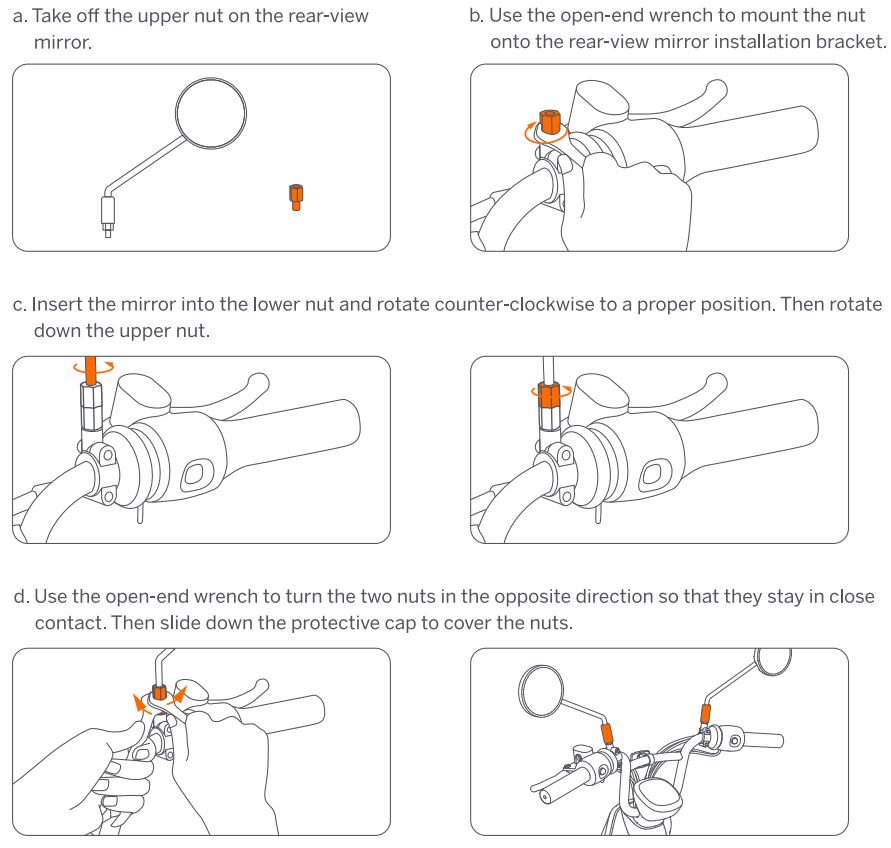

![]()
![]()
![]()
![]()
![]()
![]()
![]()
![]()
![]()
![]()
![]()
![]()
![]()
![]()
![]()
![]()
![]()
![]()
![]()
This product can only be used in areas following 16 CFR PART 1512.The manufacturer reserves the right to make changes to the product and update this manual at any time. Product parameters vary with different models. They are subject to change without prior notice. Visit www.segway.com to download the latest user materials.
[xyz-ips snippet=”download-snippet”]

